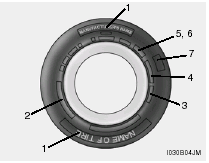Tire sidewall labeling

Federal law requires tire manufacturers to place standardized information on the sidewall of all tires. This information identifies and describes the fundamental characteristics of the tire and also provides the tire identification number (TIN) for safety standard certification.
The TIN can be used to identify the tire in case of a recall.
1. Manufacturer or Brand name.
o Manufacturer or Brand name is shown.
2. Tire size
(example: P235/60R16 99T).
o The "P" indicates the tire is designed for passenger vehicles. A "T" is the designation for a temporary spare tire.
o Three-digit number (235): This number gives the width in millimeters of the tire from sidewall edge to sidewall edge.
o Two-digit number (60): This number, known as the aspect ratio, gives the tire's ratio of height to width.
o R: The "R" stands for radial.
o Two-digit number (16): This number is the wheel or rim diameter in inches.
o Two (or three) digit number (99): This number is the tire's load index.
It is a measurement of how much weight each tire can support.
o T: Speed Rating. The speed rating denotes the speed at which a tire is designed to be driven for extended periods of time. The ratings range from "A" to "Z" (98 to 186 MPH).
3. TIN
(Tire Identification Number) for new tire (example: DOT XX XX XXX XXXX).
o DOT: Abbreviation for the "Department
of Transportation". The symbol
can be placed above, below or
to the left or right of the Tire Iden
tification Number. Indicates tire is
in compliance with the U.S. Department
of Transportation Motor
Vehicle Safety Standards.
o 1st two-digit code: Manufacturer's
identification mark
o 2nd two-digit code: Tire size
o 3rd three-digit code: Tire type code
(Optional)
o 4th four-digit code: Date of Manufacture
o Four numbers represent the week
and year the tire was built. For
example, the numbers 3105 means
the 31st week of 2005.
4. Tire ply composition and material.
The number of layers or plies of rubbercoated fabric in the tire. Tire manufacturers also must indicate the materials in the tire, which include steel, nylon, polyester, and others. The letter "R" means radial ply construction; the letter "D" means diagonal or bias ply construction; and the letter "B" means belted-bias ply construction.
5. Maximum permissible inflation pressure.
This number is the greatest amount of air pressure that should be put in the tire. Do not exceed the maximum permissible inflation pressure. Refer to the Tire and Loading Information label for recommended inflation pressure.
6. Maximum load rating.
This number indicates the maximum load in kilograms and pounds that can be carried by the tire. When replacing the tires on the vehicle, always use a tire that has the same load rating as the factory installed tire.
7. Uniform Tire Quality Grading (UTQG):
Tire manufacturers are required to grade tires based on three performance factors: treadwear, traction and temperature resistance. For more information, see Uniform Tire Quality Grading.
See also:
Air bag inflation conditions
Front air bags
Front air bags are designed to inflate in a frontal collision depending on the
intensity, speed or angles of impact of the front collision. ...
Disarmed stage
Using the smart key
The system will be disarmed when the doors are unlocked by pressing the unlock
button on the smart key or pressing the lock/unlock button of the front outside
door handle with ...
Battery recharging
Your vehicle has a maintenance-free, calcium-based battery.
• If the battery becomes discharged in a short time (because, for example, the
headlights or interior lights were left on while the vehic ...


